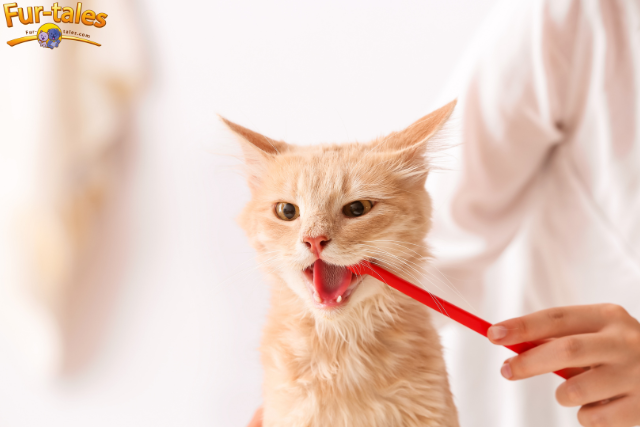
How to Brush Your Cat’s Teeth Without Stress
Dental hygiene is just as important for cats as it is for humans, yet it’s often overlooked until bad breath or gum disease sets in. Brushing your cat’s teeth might sound like a recipe for scratched arms and feline fury, but with the right approach, it can be a stress-free (and even bonding) experience for both you and your kitty.
In this article, we’ll walk you through why feline dental care matters, how to introduce brushing gradually, and techniques to make the process as easy and calm as possible.
Why Brushing Your Cat’s Teeth Is Important
Many cat parents are surprised to learn that periodontal disease is one of the most common health issues in cats. By the age of three, most cats show signs of dental problems.
Benefits of brushing:
- Prevents plaque and tartar buildup
- Reduces risk of gum disease and tooth loss
- Improves breath
- Supports overall health — oral bacteria can affect the kidneys, liver, and heart
Regular brushing can significantly reduce the need for costly dental procedures down the line.
When to Start Brushing
The best time to start brushing your cat’s teeth is when they’re young and still curious, but it’s never too late. Even older cats can learn to tolerate brushing with patience and gentle training.
Signs your cat may need brushing (or a vet check):
- Bad breath
- Drooling
- Yellow or brown teeth
- Red or swollen gums
- Pawing at the mouth or eating less
What You’ll Need
Before you begin, gather the right tools:
- Cat-safe toothbrush: Small and soft-bristled. Finger brushes or angled pet toothbrushes work well.
- Pet toothpaste: Never use human toothpaste. Look for flavors cats enjoy, like poultry or fish.
- Treats: To reward your cat after each session
- Towel or blanket: Optional, for gentle restraint if needed
Step-by-Step Guide: Brushing Without Stress
???? Step 1: Get Your Cat Used to Mouth Handling
Goal: Help your cat feel comfortable having their face and mouth touched.
- Gently stroke around their cheeks, lips, and chin during cuddle time.
- Offer treats or praise after each session.
- Do this daily for 3–5 days before introducing brushing.
???? Step 2: Introduce the Toothpaste (Without the Brush)
Goal: Let your cat taste and explore the toothpaste.
- Put a small amount of toothpaste on your finger.
- Let your cat lick it off.
- You can dab a bit on their lips or gums if they’re curious.
- Repeat for a few days to build positive associations.
???? Step 3: Start with a Finger Brush or Gauze
Goal: Gently clean the teeth with a soft material before using a toothbrush.
- Wrap gauze around your finger or use a rubber finger brush.
- Apply toothpaste and gently rub along the outer surface of the teeth.
- Focus on the canines and molars where plaque builds up most.
- Keep sessions under 30 seconds at first.
???? Step 4: Graduate to a Toothbrush
Goal: Use a proper toothbrush once your cat is comfortable.
- Angle the brush slightly and use small circular motions.
- Focus only on the outside of the teeth—cats use their tongue to clean the inner surfaces.
- Don’t worry if you only get a few teeth at first—consistency matters more than perfection.
???? Step 5: Keep It Short and Sweet
- End each session on a positive note—even if you didn’t finish.
- Give your cat a high-value treat or playtime as a reward.
- Try to brush 2–3 times a week to maintain good oral health.
Tips for Success
- Pick a quiet time: Avoid brushing when your cat is energetic or irritated.
- Use positive reinforcement: Praise, treats, or affection after each session help build trust.
- Stay calm: Cats can sense frustration. If you’re tense, they’ll be too.
- Never force it: If your cat struggles, pause and try again later.
What If Your Cat Just Won’t Cooperate?
Some cats may never tolerate brushing, and that’s okay. You still have options:
Alternatives to Brushing:
- Dental treats: Look for VOHC-approved dental chews that help reduce tartar.
- Dental diets: Some vet-approved foods are designed to clean teeth mechanically.
- Water additives: Flavorless solutions added to your cat’s water to combat plaque.
- Vet cleanings: Professional dental cleanings under anesthesia are sometimes necessary.
How Often Should You Brush?
Ideally: Daily, just like humans.
Realistically: Aim for 2–3 times per week. This is enough to keep plaque at bay and support long-term dental health.
Brushing your cat’s teeth doesn’t have to be a battle. By starting slow, being patient, and rewarding positive behavior, you can transform a dreaded chore into a bonding routine. A few minutes of effort each week can add years of health and comfort to your cat’s life.
So grab that chicken-flavored toothpaste, a soft brush, and let your purring partner show you how adaptable they can be.
Image Designed Using Canva
